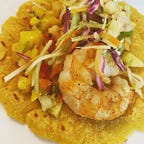Chardonnay Lovers: What You Need to Know about Chablis
Chablis, France. A white wine region with fabulous, bright and zesty Chardonnays.
Chablis (sha-blee) is a region located in North-Central France. It’s an outlier to Burgundy considering that it’s geographically (and viticulturally) closer to Champagne. It’s the northernmost winegrowing region for still Chardonnay in the world. It’s cold and damp — so the soil and the weather mean everything to the growers. It also means it’s not oaky and buttery like Napa Chardonnays can be.
Two incredibly knowledgeable authors, Jordan Mackay and Rajat Paar, state that Chablis is “one of the greatest demonstrations of terroir on the planet” because it is “the only place where Chardonnay needs nothing — no bubbles, no lees stirring, no new oak… to be captivating” (The Sommeliers Atlas of Taste). Chablis truly is distinctive when tasted alongside Chardonnays from other regions. Not only that, but you can taste a difference between the varying qualities of Chablis. Grapes from certain areas do taste different than grapes from others just miles away.
Chablis produces wines made only from the Chardonnay grape. Confusingly, for us in America, none of these wines are called “Chardonnay” and rarely do they ever list “chardonnay” on the bottle. Instead, the label will say, Chablis, Petit Chablis, or Chablis Grand Cru. These are called, AOPs (Appellation d’Origine Protégée) which is a specially demarcated region that has standards for the quality of the products that carry the region name.
Chablis Grand Cru is the highest quality region with the strictest standards for wine growing and making. Second, is Chablis AOP which is comprised of 40 premier cru vineyards, further divided into 17 major vineyards. Petit Chablis is the least regulated and lowest quality product — this does not mean it is bad! Simply that it is a different product from different soils than the grand or premier vineyards.
How did they decide what qualities to give these areas? Soil. The 7 Grand Cru vineyards are located on Kimmeridgian marl, which is a mixture of limestone, clay and oyster fossils. There’s a lot of reasons why this soil is important, some being drainage and the level of minerality imparted by oyster shells and limestone. These wines will have a higher minerality (some say chalky notes) in the taste than the Petit Chablis wines. The Petit Chablis vineyards are located on elevated hillsides where this Kimmeridgian marl is not as accessible to the vines because it lays under Portland limestone — a limestone less diverse than the Kimmeridgian.
Amongst the 7 Grand Crus — Bougros, Presuses, Vaudesir, Grenouilles, Valmur, Les Clos and Blanchots — Les Clos is the most prestigious. It encompasses a huge area of land that faces south and southwest with those great soils we talked about earlier. Presuses is the most south facing and low sloped which causes the resulting wines to consist of riper fruits and a bit less minerality than what Les Clos and other Grand Crus would have. While Les Clos takes a long time to reach its prime drinking stage, Blanchots is filled with tart lively fruits that can be drunk without further aging.
Premier Crus of note often come from Fourchaume, Montee de Tonnerre, Vaillons and Montmains. The latter two are split from the former two by the Serein river.
Some great, affordable, producers from Chablis are William Fevre, Alice and Olivier de Moore, and Patrick Piuze. Check these guys out if you want to see what Chablis all is about without spending a Grand Cru price on a bottle.
